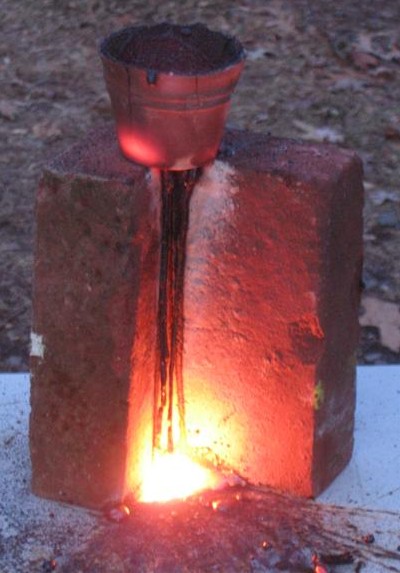
Recipe 1
From the Thermate recipe in Arson Around With Auntie ALF: “Thermate is similar to commercial thermite, used in welding, except that it also contains an oxidizer, making it easier to ignite. Thermate will readily burn paper, rags, excelsior, straw, and other tinder type materials. However, its main use in sabotage operations is against motors, gears, lathes, or other metal targets – to weld moving parts together, warp precision machined surfaces, and so on. Since it burns with a brief, almost explosive action, it is not recommended for burning wooden structures or other materials where persistent heat is required.”
Recipe 2
Thermite is an incendiary reaction that can burn as hot as 2500°C or more. That means that if you lit a pound of thermite on top of your car it would melt through your hood, through your engine, through your driveway, and make a hole in the ground. Thermite is a reaction between a metal (aluminum, magnesium) and a metal oxide (iron oxide, copper oxide, manganese oxide…) this reaction has a high ignition temperature, but once its ignited it supplies it’s own oxygen. This allows for some interesting applications, for example thermite is still used today for underwater welding.
Safety Precautions
Before you get started, you must realize that what you are about to do is a dangerous and energetic reaction that should only be performed with the utmost care. Besides its ridiculously high temperature, thermite also emits UV radiation that can do permanent damage to your eyes and if you don’t want to wear a welding mask, at least put on a pair of good quality sun glasses. Also, metals with a low melting point (zinc, lead) will vaporize and explode if near the thermite reaction.
Supplies
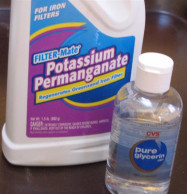
There are many kinds of thermite, but the most common uses iron oxide and aluminum powder, both of which can be made at home (see my instructions for How to Make Iron Oxide and How to Make Aluminum Powder). You also need a way to ignite the thermite. Most people use magnesium ribbon, but I haven’t had much luck with that and usually use potassium permanganate and glycerine. Potassium permanganate is a filter cleaner and a dye sold at hardware stores.
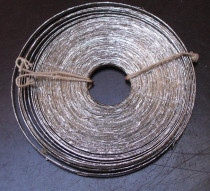
Glycerine is a skin care produce and can be found at any drug store like CVS. When mixed they spurt flames like my mother’s cooking. Additional things that you might want include a flowerpot to contain the mixture while it’s burning, bricks to hold it up, and something to melt. If you don’t have anything to destroy, at the very least just put some sand under it to keep it from ruining your driveway. What ever you do, don’t use water to catch the drops. Water will instantly vaporize, explode, and spray you with molten iron- generally something to avoid. If you’re interested, this is an example of what happens when you have even the slightest amount of moisture.
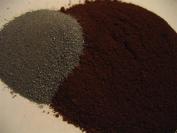
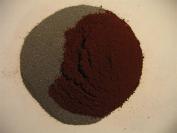
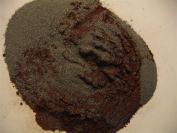
1. By weight the ratio of iron oxide to aluminum powder is 8-3. Both should be powdered as fine as possible as this will make it burn hotter and ignite easier. Measure them out, and mix as thoroughly as possible- this will make it burn faster and hotter and is well worth your time.
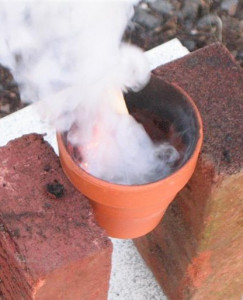
2. Pour the thermite into your container. Flower pots are most commonly used, but almost anything will work. Flower pots are used because clay is one of the only materials that will still be there after hell has reigned. If you do use a flower pot, you should consider using two. The second pot will contain the shards of the first and reduce the risk of it breaking halfway through. The only thing that I would advise against is glass as it might shatter before it melts.
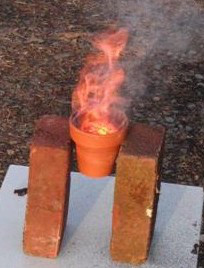
3. If you’re using magnesium, stick it in, fray the top to make it easier to light, and light it. If you’re using potassium permanganate, then pour it in, mix it in a little bit with the thermite, and add the glycerine. Rule of thumb is two to three parts glycerine to one part potassium permanganate. It usually helps to stir the ingredients after you add the glycerine. If it still won’t light, adding powdered magnesium or powder rubbed off of a sparkler makes it easier to ignite. Whatever you do, stand way back.
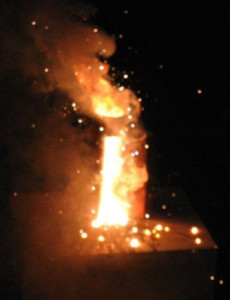
4. If it lights, then yell, cheer, and behold the awesome power of thermite. If it doesn’t light, then re-evaluate and try something different.
Recipe 3
From Skylighter
What is Thermite?
Thermite is a pyrotechnic composition usually consisting of metal powder and a metal oxide. It is not usually explosive, but it does create extremely high temperatures in a very small area for a short period of time. For instance, aluminum/iron-oxide thermite temperatures are as high as 4500 degrees F.
Thermite is used for welding, metal cutting or boring, field-expedient metal repairs, science demonstrations, high temperature ignition, disabling military equipment (including artillery, document files, and hard drives), and other applications.
Making Thermite Using Red Iron Oxide
Having the correct balance of fuel and oxidizer is key to having a stable burn in a thermite reaction. The thermite recipe for red iron oxide and aluminum is 3 parts iron oxide red to 1 part aluminum fuel. In pyrotechnic compositions the finer the ingredients and more well mixed they are, generally the easier it is to ignite, and the faster the reaction will progress.
So our goals in selecting thermite ingredients are ease of ignition and a stable, non-explosive burn.
For this example, we are using Skylighter’s -325 mesh red iron oxide and Skylighter’s -325 mesh bright aluminum, which has an average particle size of 45 microns.
Thermite#1 Mixture
| Ingredient | Parts by Wt. | Parts by % |
| Red iron oxide -325 mesh | 3 | 75 |
| Aluminum flake -325 mesh | 1 | 25 |
| Total | 100% |
To make a 4 ounce batch of thermite, first weigh out 3 ounces of red iron oxide. Then weigh out 1 ounce of aluminum powder. Dump them into a plastic tub, and put the top on. Shake them until the color is consistent throughout.
Then pass the mix through a 20-mesh or finer screen. If there are any clumps break them up with your fingers. Screen the mix two more times, or more, until you have a uniformly colored powder.
Note: Using a 40-mesh or finer screen will make the mix much easier to ignite.
This can be a dusty process, so be sure and do it an area where the aluminum dust will not cause a problem. Do not try this where air is moving. The better you mix the ingredient, the faster and hotter the reaction will be. Thermite needs a very high temperature to ignite it.
Your thermite kit comes with 6 gold sparklers. The iron in them burns at around 1800 degrees F.
Here’s how to use sparklers to ignite your thermite. Place your thermite mix in a plastic tub. Make a hole near the bottom on the side of the tub big enough for a sparkler to go through.
Push 1 to 2 of inches of the sparkler through the hole in the side of the tub into the mix inside. Leave at least 2-3 inches of your sparkler sticking out. Place the plastic tub on a metal surface that want to burn through. Light the sparkler, and get back 40 or 50 feet.
WARNING: Do NOT attempt to ignite your thermite by dipping your sparkler into the mix by hand. The mix can and does ignite violently, and will spray you with burning metal.
WARNING: A violent ignition of thermite can throw molten metal in all directions. Do not stand close to the mix when it is igniting or burning.
TIP: If you have trouble igniting your thermite with a sparkler, try mixing some magnesium powder or chips into a small amount of thermite mix. Then you should be able to ignite the magnesium mix using your sparkler.
WARNING: Thermite burns extremely hot and produces molten iron slag that can melt though a car’s engine block! Burning thermite can spatter molten iron a long way from the burning pile. Stay as far back as you can. And make sure there is nothing nearby that can catch fire. Start your thermite experiments with small amounts at first, until you understand how it behaves, and how far it will throw molten metal slag.
WARNING: You cannot extinguish a thermite fire with water. Do not attempt to put the fire out with water, or you may have a violent, steam explosion, which can throw molten slag as well. Likewise, do not use any wet materials to attempt to extinguish the fire.
